Case Study: Managing a Suicidal Patient in Healthcare Setting
VerifiedAdded on 2022/08/12
|14
|3525
|21
Essay
AI Summary
This essay presents a detailed case study on managing a suicidal patient, focusing on a 46-year-old man, Mr. Alex, exhibiting suicidal ideation, self-harm, and other symptoms. The essay explores the application of the interpersonal theory of suicide and discusses the patient's history of borderline personality disorder, unemployment, and family history of suicide. It emphasizes the crucial role of nurses and a multidisciplinary team, including physicians, psychiatrists, counselors, and social workers, in assessment and intervention. The essay outlines the importance of a safe environment, education, and behavioral therapies like dialectical and cognitive behavioral therapy. It also considers the role of family involvement, and the use of NICE guidelines, and Peplau's theory of interpersonal relationships to achieve successful patient management and resolution, highlighting the importance of communication, empathy, and a holistic approach to care.

Running head: MANAGING A SUICIDAL PATIENT
MANAGING A SUICIDAL PATIENT
Name of the student:
Name of the university:
Author note:
MANAGING A SUICIDAL PATIENT
Name of the student:
Name of the university:
Author note:
Paraphrase This Document
Need a fresh take? Get an instant paraphrase of this document with our AI Paraphraser
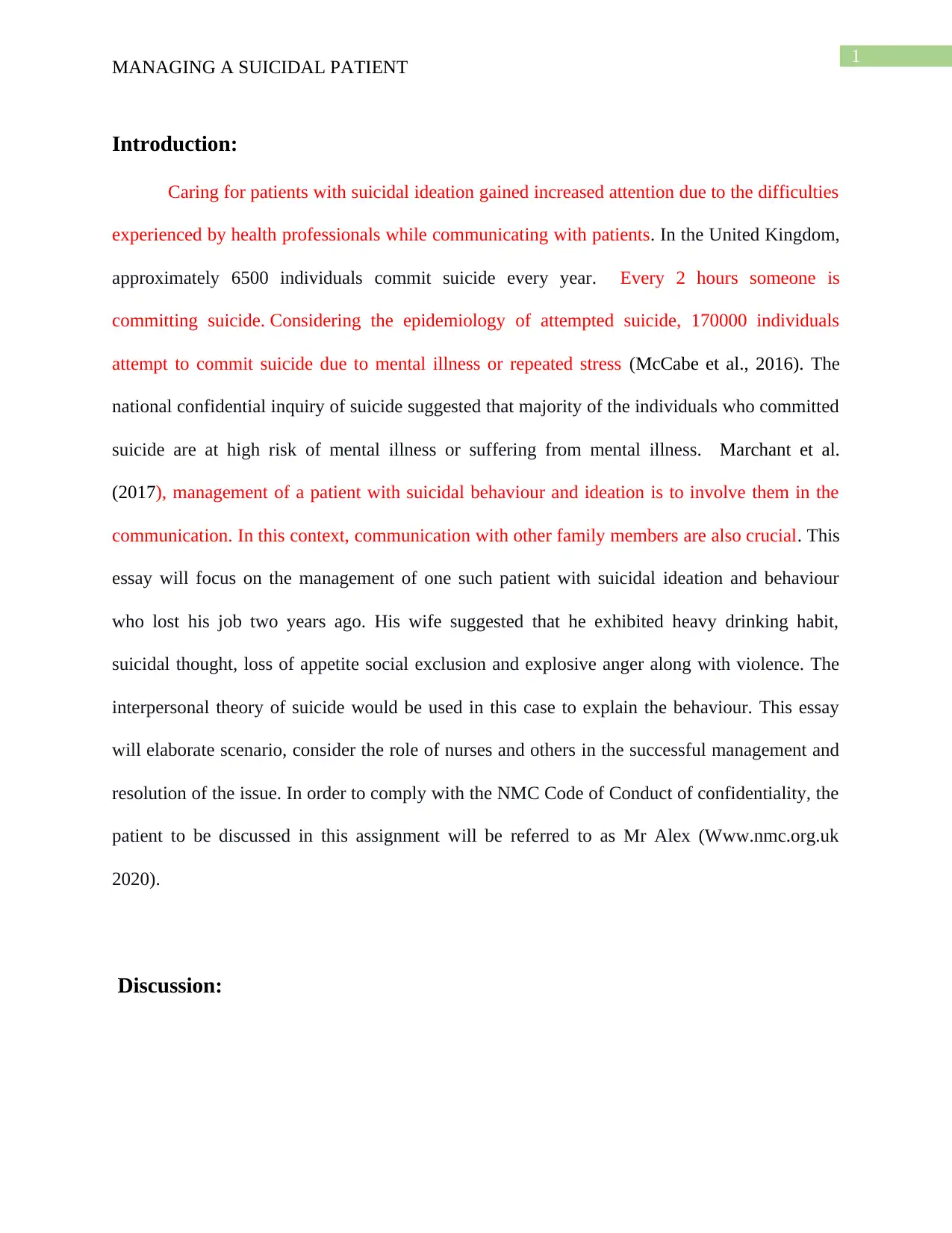
1
MANAGING A SUICIDAL PATIENT
Introduction:
Caring for patients with suicidal ideation gained increased attention due to the difficulties
experienced by health professionals while communicating with patients. In the United Kingdom,
approximately 6500 individuals commit suicide every year. Every 2 hours someone is
committing suicide. Considering the epidemiology of attempted suicide, 170000 individuals
attempt to commit suicide due to mental illness or repeated stress (McCabe et al., 2016). The
national confidential inquiry of suicide suggested that majority of the individuals who committed
suicide are at high risk of mental illness or suffering from mental illness. Marchant et al.
(2017), management of a patient with suicidal behaviour and ideation is to involve them in the
communication. In this context, communication with other family members are also crucial. This
essay will focus on the management of one such patient with suicidal ideation and behaviour
who lost his job two years ago. His wife suggested that he exhibited heavy drinking habit,
suicidal thought, loss of appetite social exclusion and explosive anger along with violence. The
interpersonal theory of suicide would be used in this case to explain the behaviour. This essay
will elaborate scenario, consider the role of nurses and others in the successful management and
resolution of the issue. In order to comply with the NMC Code of Conduct of confidentiality, the
patient to be discussed in this assignment will be referred to as Mr Alex (Www.nmc.org.uk
2020).
Discussion:
MANAGING A SUICIDAL PATIENT
Introduction:
Caring for patients with suicidal ideation gained increased attention due to the difficulties
experienced by health professionals while communicating with patients. In the United Kingdom,
approximately 6500 individuals commit suicide every year. Every 2 hours someone is
committing suicide. Considering the epidemiology of attempted suicide, 170000 individuals
attempt to commit suicide due to mental illness or repeated stress (McCabe et al., 2016). The
national confidential inquiry of suicide suggested that majority of the individuals who committed
suicide are at high risk of mental illness or suffering from mental illness. Marchant et al.
(2017), management of a patient with suicidal behaviour and ideation is to involve them in the
communication. In this context, communication with other family members are also crucial. This
essay will focus on the management of one such patient with suicidal ideation and behaviour
who lost his job two years ago. His wife suggested that he exhibited heavy drinking habit,
suicidal thought, loss of appetite social exclusion and explosive anger along with violence. The
interpersonal theory of suicide would be used in this case to explain the behaviour. This essay
will elaborate scenario, consider the role of nurses and others in the successful management and
resolution of the issue. In order to comply with the NMC Code of Conduct of confidentiality, the
patient to be discussed in this assignment will be referred to as Mr Alex (Www.nmc.org.uk
2020).
Discussion:
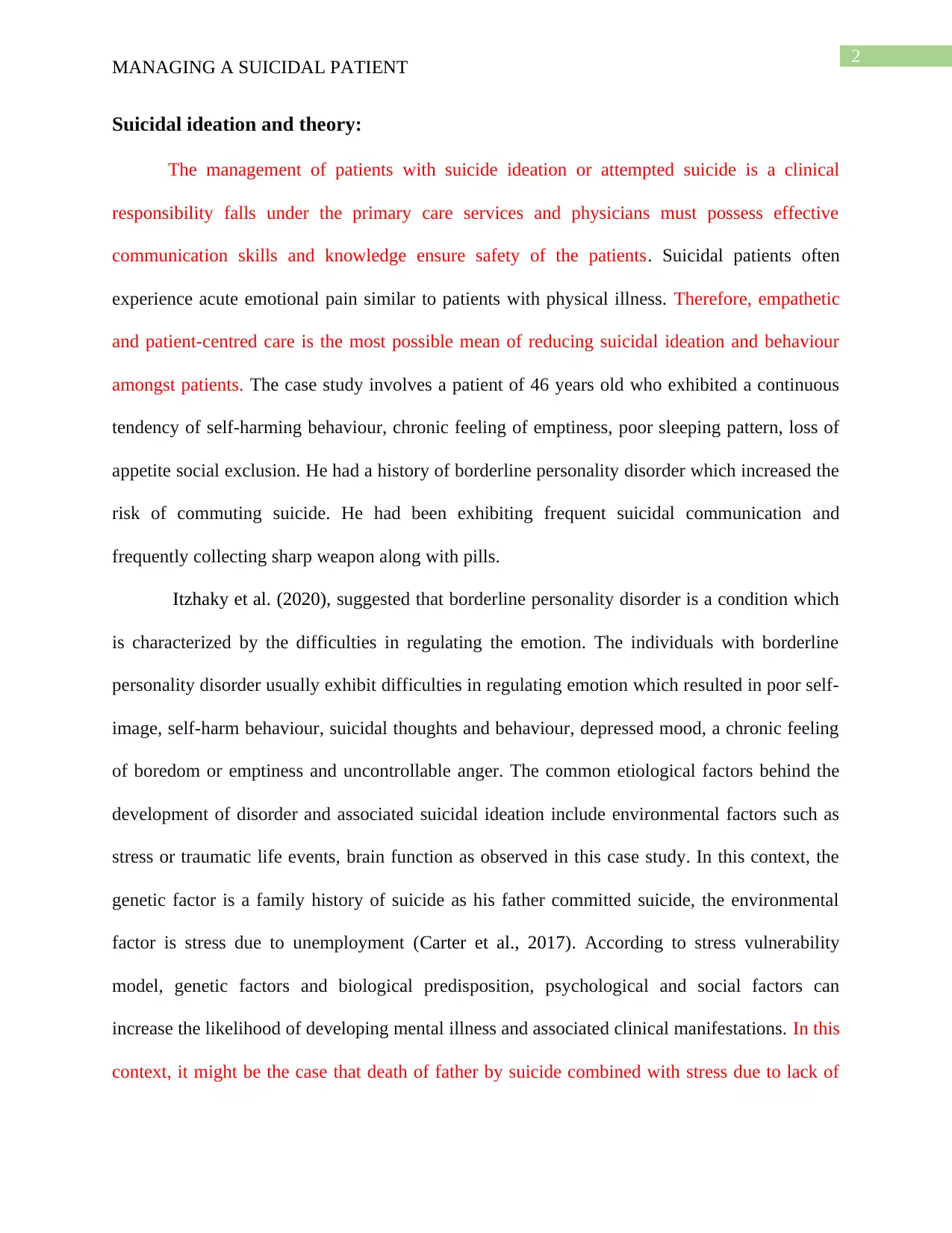
2
MANAGING A SUICIDAL PATIENT
Suicidal ideation and theory:
The management of patients with suicide ideation or attempted suicide is a clinical
responsibility falls under the primary care services and physicians must possess effective
communication skills and knowledge ensure safety of the patients. Suicidal patients often
experience acute emotional pain similar to patients with physical illness. Therefore, empathetic
and patient-centred care is the most possible mean of reducing suicidal ideation and behaviour
amongst patients. The case study involves a patient of 46 years old who exhibited a continuous
tendency of self-harming behaviour, chronic feeling of emptiness, poor sleeping pattern, loss of
appetite social exclusion. He had a history of borderline personality disorder which increased the
risk of commuting suicide. He had been exhibiting frequent suicidal communication and
frequently collecting sharp weapon along with pills.
Itzhaky et al. (2020), suggested that borderline personality disorder is a condition which
is characterized by the difficulties in regulating the emotion. The individuals with borderline
personality disorder usually exhibit difficulties in regulating emotion which resulted in poor self-
image, self-harm behaviour, suicidal thoughts and behaviour, depressed mood, a chronic feeling
of boredom or emptiness and uncontrollable anger. The common etiological factors behind the
development of disorder and associated suicidal ideation include environmental factors such as
stress or traumatic life events, brain function as observed in this case study. In this context, the
genetic factor is a family history of suicide as his father committed suicide, the environmental
factor is stress due to unemployment (Carter et al., 2017). According to stress vulnerability
model, genetic factors and biological predisposition, psychological and social factors can
increase the likelihood of developing mental illness and associated clinical manifestations. In this
context, it might be the case that death of father by suicide combined with stress due to lack of
MANAGING A SUICIDAL PATIENT
Suicidal ideation and theory:
The management of patients with suicide ideation or attempted suicide is a clinical
responsibility falls under the primary care services and physicians must possess effective
communication skills and knowledge ensure safety of the patients. Suicidal patients often
experience acute emotional pain similar to patients with physical illness. Therefore, empathetic
and patient-centred care is the most possible mean of reducing suicidal ideation and behaviour
amongst patients. The case study involves a patient of 46 years old who exhibited a continuous
tendency of self-harming behaviour, chronic feeling of emptiness, poor sleeping pattern, loss of
appetite social exclusion. He had a history of borderline personality disorder which increased the
risk of commuting suicide. He had been exhibiting frequent suicidal communication and
frequently collecting sharp weapon along with pills.
Itzhaky et al. (2020), suggested that borderline personality disorder is a condition which
is characterized by the difficulties in regulating the emotion. The individuals with borderline
personality disorder usually exhibit difficulties in regulating emotion which resulted in poor self-
image, self-harm behaviour, suicidal thoughts and behaviour, depressed mood, a chronic feeling
of boredom or emptiness and uncontrollable anger. The common etiological factors behind the
development of disorder and associated suicidal ideation include environmental factors such as
stress or traumatic life events, brain function as observed in this case study. In this context, the
genetic factor is a family history of suicide as his father committed suicide, the environmental
factor is stress due to unemployment (Carter et al., 2017). According to stress vulnerability
model, genetic factors and biological predisposition, psychological and social factors can
increase the likelihood of developing mental illness and associated clinical manifestations. In this
context, it might be the case that death of father by suicide combined with stress due to lack of
⊘ This is a preview!⊘
Do you want full access?
Subscribe today to unlock all pages.

Trusted by 1+ million students worldwide
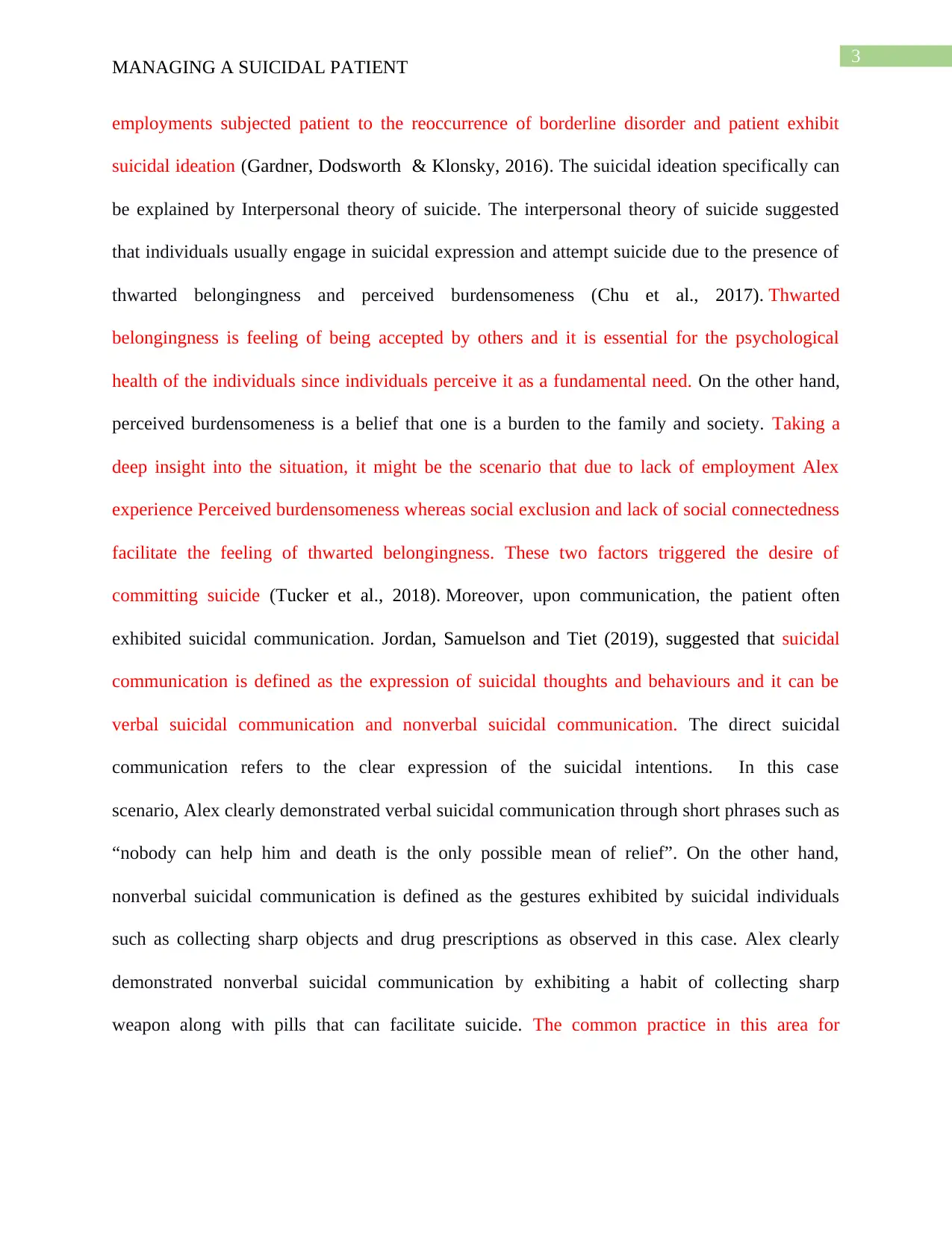
3
MANAGING A SUICIDAL PATIENT
employments subjected patient to the reoccurrence of borderline disorder and patient exhibit
suicidal ideation (Gardner, Dodsworth & Klonsky, 2016). The suicidal ideation specifically can
be explained by Interpersonal theory of suicide. The interpersonal theory of suicide suggested
that individuals usually engage in suicidal expression and attempt suicide due to the presence of
thwarted belongingness and perceived burdensomeness (Chu et al., 2017). Thwarted
belongingness is feeling of being accepted by others and it is essential for the psychological
health of the individuals since individuals perceive it as a fundamental need. On the other hand,
perceived burdensomeness is a belief that one is a burden to the family and society. Taking a
deep insight into the situation, it might be the scenario that due to lack of employment Alex
experience Perceived burdensomeness whereas social exclusion and lack of social connectedness
facilitate the feeling of thwarted belongingness. These two factors triggered the desire of
committing suicide (Tucker et al., 2018). Moreover, upon communication, the patient often
exhibited suicidal communication. Jordan, Samuelson and Tiet (2019), suggested that suicidal
communication is defined as the expression of suicidal thoughts and behaviours and it can be
verbal suicidal communication and nonverbal suicidal communication. The direct suicidal
communication refers to the clear expression of the suicidal intentions. In this case
scenario, Alex clearly demonstrated verbal suicidal communication through short phrases such as
“nobody can help him and death is the only possible mean of relief”. On the other hand,
nonverbal suicidal communication is defined as the gestures exhibited by suicidal individuals
such as collecting sharp objects and drug prescriptions as observed in this case. Alex clearly
demonstrated nonverbal suicidal communication by exhibiting a habit of collecting sharp
weapon along with pills that can facilitate suicide. The common practice in this area for
MANAGING A SUICIDAL PATIENT
employments subjected patient to the reoccurrence of borderline disorder and patient exhibit
suicidal ideation (Gardner, Dodsworth & Klonsky, 2016). The suicidal ideation specifically can
be explained by Interpersonal theory of suicide. The interpersonal theory of suicide suggested
that individuals usually engage in suicidal expression and attempt suicide due to the presence of
thwarted belongingness and perceived burdensomeness (Chu et al., 2017). Thwarted
belongingness is feeling of being accepted by others and it is essential for the psychological
health of the individuals since individuals perceive it as a fundamental need. On the other hand,
perceived burdensomeness is a belief that one is a burden to the family and society. Taking a
deep insight into the situation, it might be the scenario that due to lack of employment Alex
experience Perceived burdensomeness whereas social exclusion and lack of social connectedness
facilitate the feeling of thwarted belongingness. These two factors triggered the desire of
committing suicide (Tucker et al., 2018). Moreover, upon communication, the patient often
exhibited suicidal communication. Jordan, Samuelson and Tiet (2019), suggested that suicidal
communication is defined as the expression of suicidal thoughts and behaviours and it can be
verbal suicidal communication and nonverbal suicidal communication. The direct suicidal
communication refers to the clear expression of the suicidal intentions. In this case
scenario, Alex clearly demonstrated verbal suicidal communication through short phrases such as
“nobody can help him and death is the only possible mean of relief”. On the other hand,
nonverbal suicidal communication is defined as the gestures exhibited by suicidal individuals
such as collecting sharp objects and drug prescriptions as observed in this case. Alex clearly
demonstrated nonverbal suicidal communication by exhibiting a habit of collecting sharp
weapon along with pills that can facilitate suicide. The common practice in this area for
Paraphrase This Document
Need a fresh take? Get an instant paraphrase of this document with our AI Paraphraser
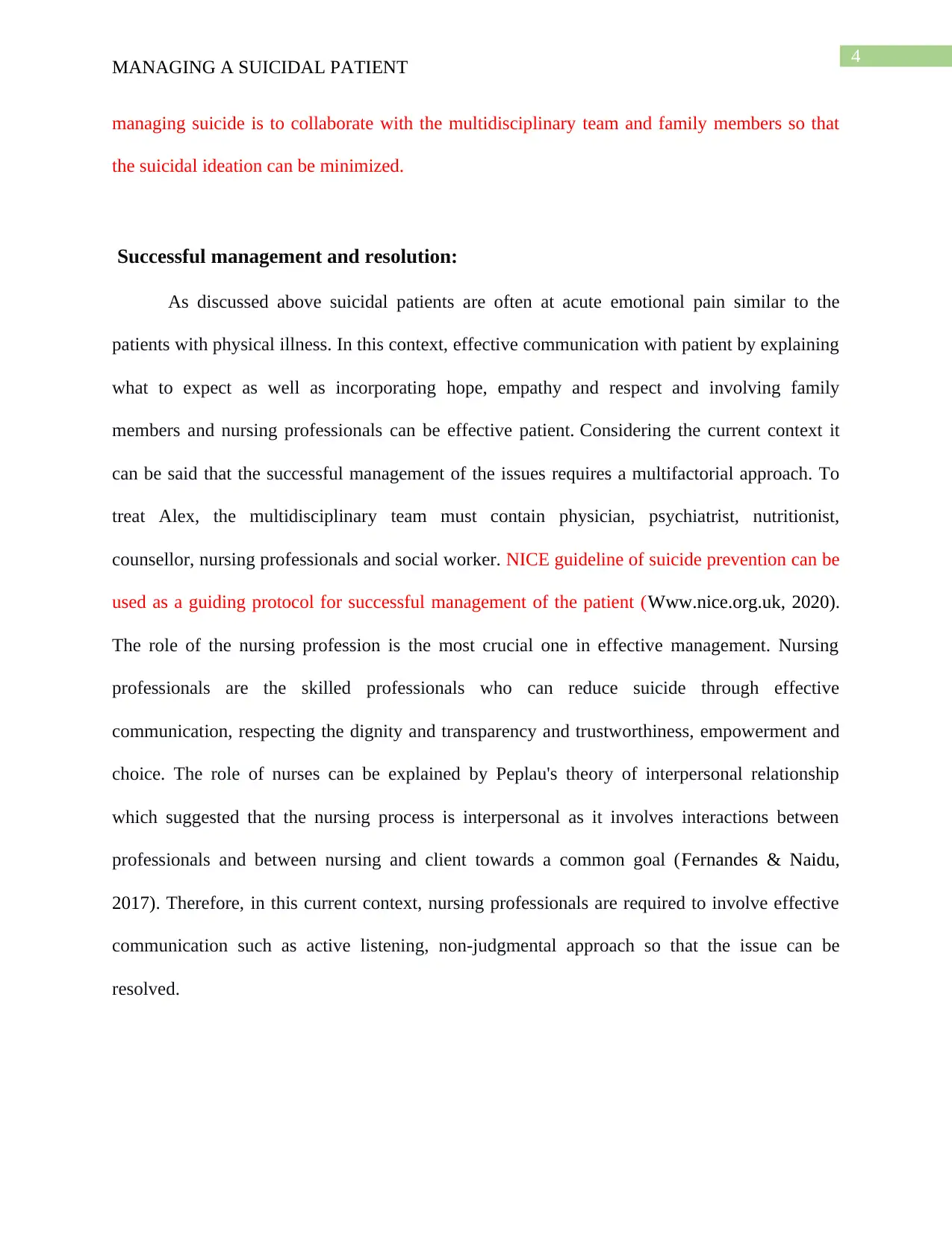
4
MANAGING A SUICIDAL PATIENT
managing suicide is to collaborate with the multidisciplinary team and family members so that
the suicidal ideation can be minimized.
Successful management and resolution:
As discussed above suicidal patients are often at acute emotional pain similar to the
patients with physical illness. In this context, effective communication with patient by explaining
what to expect as well as incorporating hope, empathy and respect and involving family
members and nursing professionals can be effective patient. Considering the current context it
can be said that the successful management of the issues requires a multifactorial approach. To
treat Alex, the multidisciplinary team must contain physician, psychiatrist, nutritionist,
counsellor, nursing professionals and social worker. NICE guideline of suicide prevention can be
used as a guiding protocol for successful management of the patient (Www.nice.org.uk, 2020).
The role of the nursing profession is the most crucial one in effective management. Nursing
professionals are the skilled professionals who can reduce suicide through effective
communication, respecting the dignity and transparency and trustworthiness, empowerment and
choice. The role of nurses can be explained by Peplau's theory of interpersonal relationship
which suggested that the nursing process is interpersonal as it involves interactions between
professionals and between nursing and client towards a common goal (Fernandes & Naidu,
2017). Therefore, in this current context, nursing professionals are required to involve effective
communication such as active listening, non-judgmental approach so that the issue can be
resolved.
MANAGING A SUICIDAL PATIENT
managing suicide is to collaborate with the multidisciplinary team and family members so that
the suicidal ideation can be minimized.
Successful management and resolution:
As discussed above suicidal patients are often at acute emotional pain similar to the
patients with physical illness. In this context, effective communication with patient by explaining
what to expect as well as incorporating hope, empathy and respect and involving family
members and nursing professionals can be effective patient. Considering the current context it
can be said that the successful management of the issues requires a multifactorial approach. To
treat Alex, the multidisciplinary team must contain physician, psychiatrist, nutritionist,
counsellor, nursing professionals and social worker. NICE guideline of suicide prevention can be
used as a guiding protocol for successful management of the patient (Www.nice.org.uk, 2020).
The role of the nursing profession is the most crucial one in effective management. Nursing
professionals are the skilled professionals who can reduce suicide through effective
communication, respecting the dignity and transparency and trustworthiness, empowerment and
choice. The role of nurses can be explained by Peplau's theory of interpersonal relationship
which suggested that the nursing process is interpersonal as it involves interactions between
professionals and between nursing and client towards a common goal (Fernandes & Naidu,
2017). Therefore, in this current context, nursing professionals are required to involve effective
communication such as active listening, non-judgmental approach so that the issue can be
resolved.
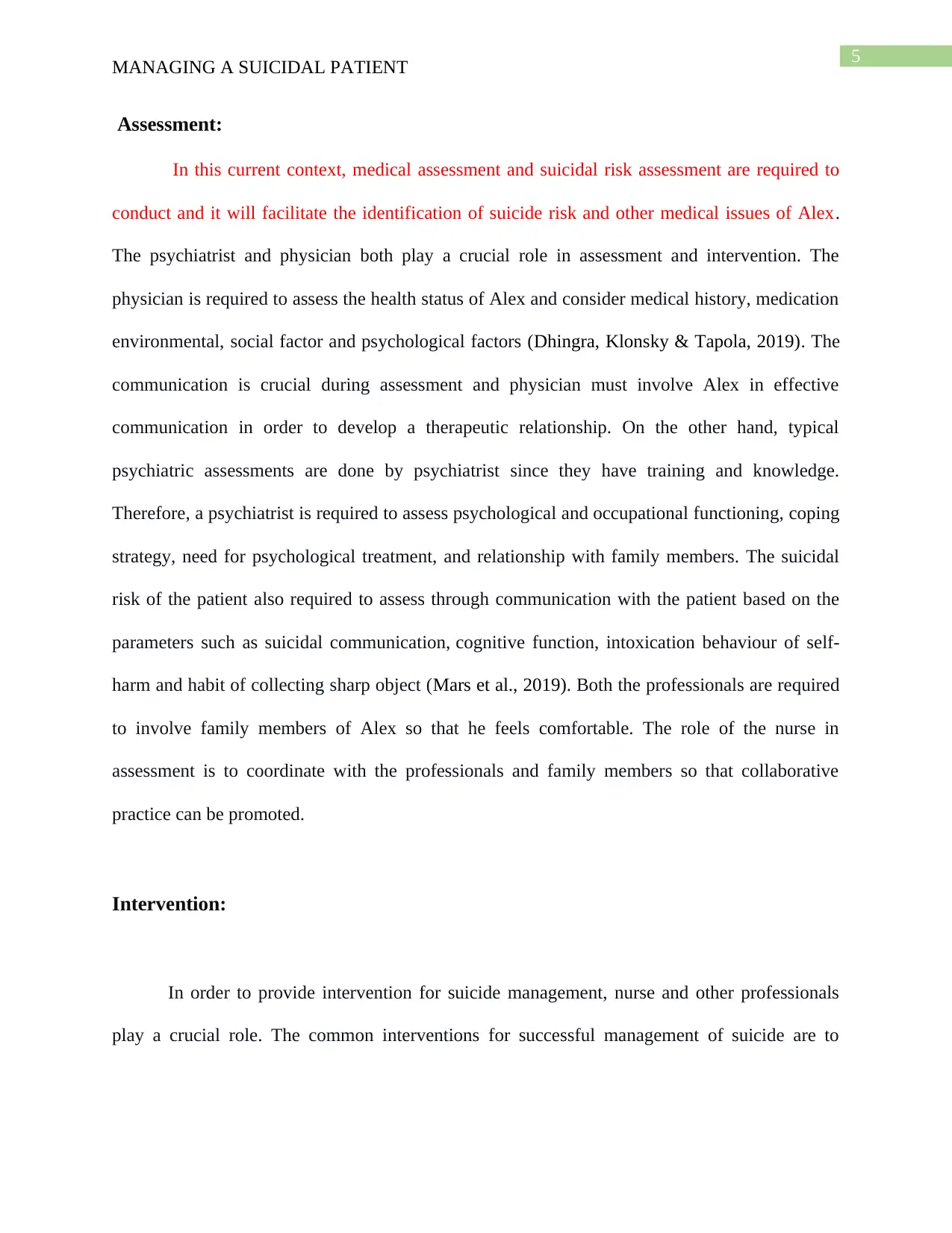
5
MANAGING A SUICIDAL PATIENT
Assessment:
In this current context, medical assessment and suicidal risk assessment are required to
conduct and it will facilitate the identification of suicide risk and other medical issues of Alex.
The psychiatrist and physician both play a crucial role in assessment and intervention. The
physician is required to assess the health status of Alex and consider medical history, medication
environmental, social factor and psychological factors (Dhingra, Klonsky & Tapola, 2019). The
communication is crucial during assessment and physician must involve Alex in effective
communication in order to develop a therapeutic relationship. On the other hand, typical
psychiatric assessments are done by psychiatrist since they have training and knowledge.
Therefore, a psychiatrist is required to assess psychological and occupational functioning, coping
strategy, need for psychological treatment, and relationship with family members. The suicidal
risk of the patient also required to assess through communication with the patient based on the
parameters such as suicidal communication, cognitive function, intoxication behaviour of self-
harm and habit of collecting sharp object (Mars et al., 2019). Both the professionals are required
to involve family members of Alex so that he feels comfortable. The role of the nurse in
assessment is to coordinate with the professionals and family members so that collaborative
practice can be promoted.
Intervention:
In order to provide intervention for suicide management, nurse and other professionals
play a crucial role. The common interventions for successful management of suicide are to
MANAGING A SUICIDAL PATIENT
Assessment:
In this current context, medical assessment and suicidal risk assessment are required to
conduct and it will facilitate the identification of suicide risk and other medical issues of Alex.
The psychiatrist and physician both play a crucial role in assessment and intervention. The
physician is required to assess the health status of Alex and consider medical history, medication
environmental, social factor and psychological factors (Dhingra, Klonsky & Tapola, 2019). The
communication is crucial during assessment and physician must involve Alex in effective
communication in order to develop a therapeutic relationship. On the other hand, typical
psychiatric assessments are done by psychiatrist since they have training and knowledge.
Therefore, a psychiatrist is required to assess psychological and occupational functioning, coping
strategy, need for psychological treatment, and relationship with family members. The suicidal
risk of the patient also required to assess through communication with the patient based on the
parameters such as suicidal communication, cognitive function, intoxication behaviour of self-
harm and habit of collecting sharp object (Mars et al., 2019). Both the professionals are required
to involve family members of Alex so that he feels comfortable. The role of the nurse in
assessment is to coordinate with the professionals and family members so that collaborative
practice can be promoted.
Intervention:
In order to provide intervention for suicide management, nurse and other professionals
play a crucial role. The common interventions for successful management of suicide are to
⊘ This is a preview!⊘
Do you want full access?
Subscribe today to unlock all pages.

Trusted by 1+ million students worldwide

6
MANAGING A SUICIDAL PATIENT
provide a safe environment (removing lethal object), patient education and behavioural therapy
(dialectical therapy and cognitive behavioural therapy).
Providing safe environment:
In order to develop a safe environment, nursing professionals and family members play
a crucial role. As discussed by suicidal patients often experience insecurity, hopelessness, low
self-esteem and low self-confidence. The family members also often experience helpless and
subjected to psychological distress such as anxiety and distress as observed in this case. In this
case, nursing professional is required to provide involve in effective communication with patient
and family through active listening, non-judgemental attitude and empathy (Vahidi et al., 2019).
Alex already experienced hopelessness and suicidal ideation. In this context, effective
communication of the nurses with the patient will reflect reflects empathy, respect and hope will
empower patient. His wife can be involved in shared decision making of the treatment for
increasing a sense of purpose and belongingness and it will reduce suicide ideation by building
a safe environment (Gorton, 2019). The sharp object can be eliminated from his immediate
environment and nursing professionals must monitor the tendency of attempting suicide or
suicidal thoughts. CCTV is required to install in the home setting for reducing the suicidal
ideation. The nursing professionals must ensure that the patient involved in appropriate sleep
hygiene so that his sleeping pattern can be improved. The nutritionist can take part, in this case,
to improve the diet of the patient so that his appetite can be increased.
Education:
Education and literacy can be provided to Alex by nursing professionals in order to
reduce the suicidal ideation. According to Suicide prevention strategy for England and first even
cross-government suicide prevention plan, it is crucial to provide education to the family and
MANAGING A SUICIDAL PATIENT
provide a safe environment (removing lethal object), patient education and behavioural therapy
(dialectical therapy and cognitive behavioural therapy).
Providing safe environment:
In order to develop a safe environment, nursing professionals and family members play
a crucial role. As discussed by suicidal patients often experience insecurity, hopelessness, low
self-esteem and low self-confidence. The family members also often experience helpless and
subjected to psychological distress such as anxiety and distress as observed in this case. In this
case, nursing professional is required to provide involve in effective communication with patient
and family through active listening, non-judgemental attitude and empathy (Vahidi et al., 2019).
Alex already experienced hopelessness and suicidal ideation. In this context, effective
communication of the nurses with the patient will reflect reflects empathy, respect and hope will
empower patient. His wife can be involved in shared decision making of the treatment for
increasing a sense of purpose and belongingness and it will reduce suicide ideation by building
a safe environment (Gorton, 2019). The sharp object can be eliminated from his immediate
environment and nursing professionals must monitor the tendency of attempting suicide or
suicidal thoughts. CCTV is required to install in the home setting for reducing the suicidal
ideation. The nursing professionals must ensure that the patient involved in appropriate sleep
hygiene so that his sleeping pattern can be improved. The nutritionist can take part, in this case,
to improve the diet of the patient so that his appetite can be increased.
Education:
Education and literacy can be provided to Alex by nursing professionals in order to
reduce the suicidal ideation. According to Suicide prevention strategy for England and first even
cross-government suicide prevention plan, it is crucial to provide education to the family and
Paraphrase This Document
Need a fresh take? Get an instant paraphrase of this document with our AI Paraphraser

7
MANAGING A SUICIDAL PATIENT
patient regarding suicide. Nursing professional can provide education to the family members
regarding the safety of the patient, tendency of self-harm, impact suicide and skills for
supporting Alex. The education can be given to Alex regarding negative consequences of
suicidal ideation and consumption of alcohol through effective communication (Fitzpatrick,
2020). The nursing profession must encourage Alex to live a healthy life through motivational
therapy combined with education. It will empower the patient to reduce suicide ideation and gain
the purpose of living a healthy life (Martin, 2017).
Behavioural therapy:
In order to reduce suicidal thoughts and self-harm tendency, dialectical therapy and
cognitive behavioural therapy. Dialectical behavioural therapy (DBT) is a type of cognitive
behavioural therapy that identify as well as change the negative thought process and pushes for
positive behavioural changes and therefore, it is used for treating suicidal and other self-
destructive behaviours amongst the patient `( Mills et al., 2019). Unlike CBT, it greatly focused
on the social and emotional aspect of the individuals and assist patients to cope with unstable
emotions and harmful behaviour. On the other hand, cognitive behavioural therapy can be used
to assist patients in controlling thoughts, feeling and behaviours (Wright et al., 2017). A
counsellor can take part in this case as a counsellor have the skills to alter the thought process.
Similar to nursing professionals, the counsellor must use effective communication skills so that
the patient feel safe and develop help-seeking behaviour without any stigma.
The social worker in this case scenario can play a vital role since the social worker can
provide referral or recommendation employment opportunities based on the qualification, job
experience. The social worker must inform family members of Alex and nursing professional
MANAGING A SUICIDAL PATIENT
patient regarding suicide. Nursing professional can provide education to the family members
regarding the safety of the patient, tendency of self-harm, impact suicide and skills for
supporting Alex. The education can be given to Alex regarding negative consequences of
suicidal ideation and consumption of alcohol through effective communication (Fitzpatrick,
2020). The nursing profession must encourage Alex to live a healthy life through motivational
therapy combined with education. It will empower the patient to reduce suicide ideation and gain
the purpose of living a healthy life (Martin, 2017).
Behavioural therapy:
In order to reduce suicidal thoughts and self-harm tendency, dialectical therapy and
cognitive behavioural therapy. Dialectical behavioural therapy (DBT) is a type of cognitive
behavioural therapy that identify as well as change the negative thought process and pushes for
positive behavioural changes and therefore, it is used for treating suicidal and other self-
destructive behaviours amongst the patient `( Mills et al., 2019). Unlike CBT, it greatly focused
on the social and emotional aspect of the individuals and assist patients to cope with unstable
emotions and harmful behaviour. On the other hand, cognitive behavioural therapy can be used
to assist patients in controlling thoughts, feeling and behaviours (Wright et al., 2017). A
counsellor can take part in this case as a counsellor have the skills to alter the thought process.
Similar to nursing professionals, the counsellor must use effective communication skills so that
the patient feel safe and develop help-seeking behaviour without any stigma.
The social worker in this case scenario can play a vital role since the social worker can
provide referral or recommendation employment opportunities based on the qualification, job
experience. The social worker must inform family members of Alex and nursing professional
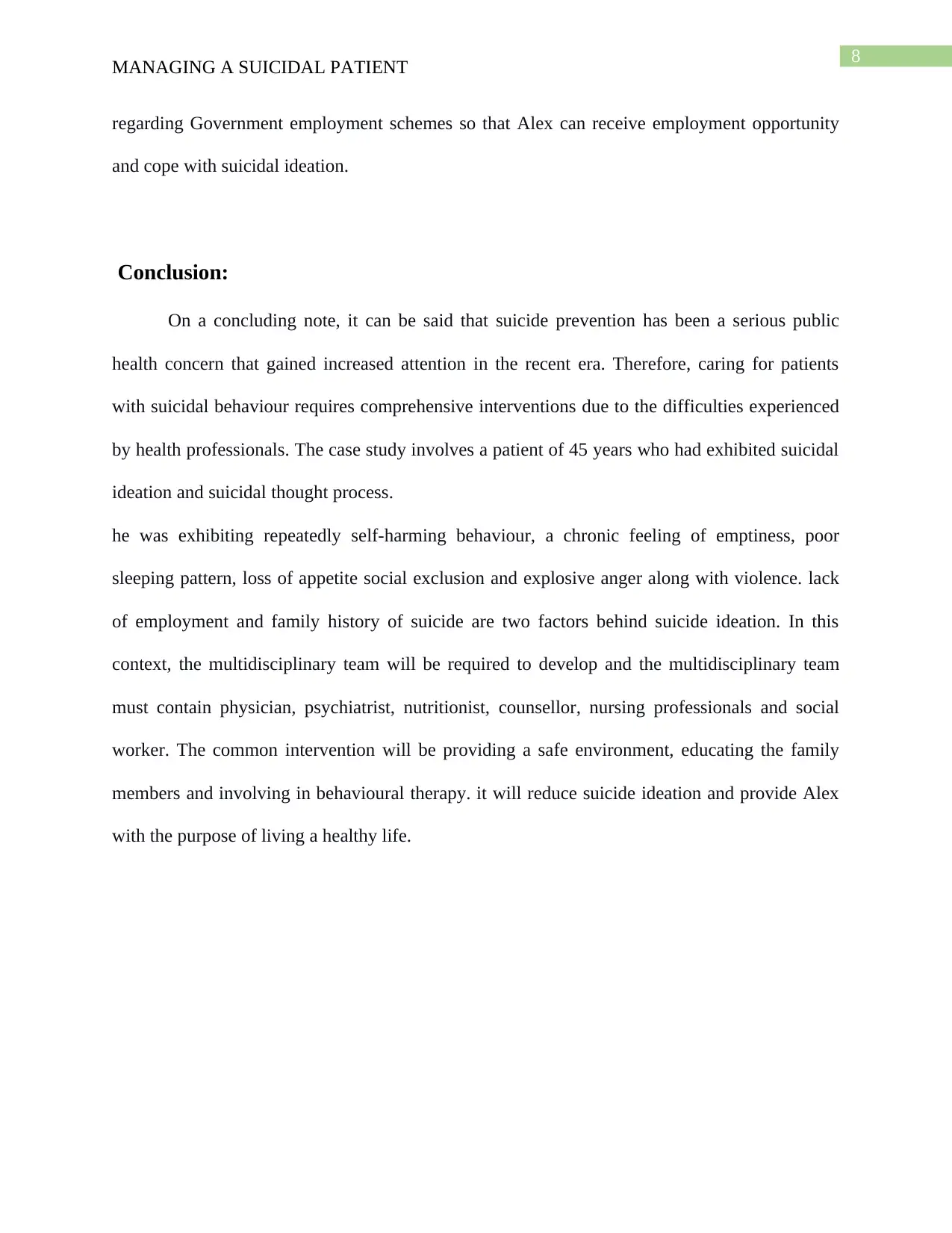
8
MANAGING A SUICIDAL PATIENT
regarding Government employment schemes so that Alex can receive employment opportunity
and cope with suicidal ideation.
Conclusion:
On a concluding note, it can be said that suicide prevention has been a serious public
health concern that gained increased attention in the recent era. Therefore, caring for patients
with suicidal behaviour requires comprehensive interventions due to the difficulties experienced
by health professionals. The case study involves a patient of 45 years who had exhibited suicidal
ideation and suicidal thought process.
he was exhibiting repeatedly self-harming behaviour, a chronic feeling of emptiness, poor
sleeping pattern, loss of appetite social exclusion and explosive anger along with violence. lack
of employment and family history of suicide are two factors behind suicide ideation. In this
context, the multidisciplinary team will be required to develop and the multidisciplinary team
must contain physician, psychiatrist, nutritionist, counsellor, nursing professionals and social
worker. The common intervention will be providing a safe environment, educating the family
members and involving in behavioural therapy. it will reduce suicide ideation and provide Alex
with the purpose of living a healthy life.
MANAGING A SUICIDAL PATIENT
regarding Government employment schemes so that Alex can receive employment opportunity
and cope with suicidal ideation.
Conclusion:
On a concluding note, it can be said that suicide prevention has been a serious public
health concern that gained increased attention in the recent era. Therefore, caring for patients
with suicidal behaviour requires comprehensive interventions due to the difficulties experienced
by health professionals. The case study involves a patient of 45 years who had exhibited suicidal
ideation and suicidal thought process.
he was exhibiting repeatedly self-harming behaviour, a chronic feeling of emptiness, poor
sleeping pattern, loss of appetite social exclusion and explosive anger along with violence. lack
of employment and family history of suicide are two factors behind suicide ideation. In this
context, the multidisciplinary team will be required to develop and the multidisciplinary team
must contain physician, psychiatrist, nutritionist, counsellor, nursing professionals and social
worker. The common intervention will be providing a safe environment, educating the family
members and involving in behavioural therapy. it will reduce suicide ideation and provide Alex
with the purpose of living a healthy life.
⊘ This is a preview!⊘
Do you want full access?
Subscribe today to unlock all pages.

Trusted by 1+ million students worldwide
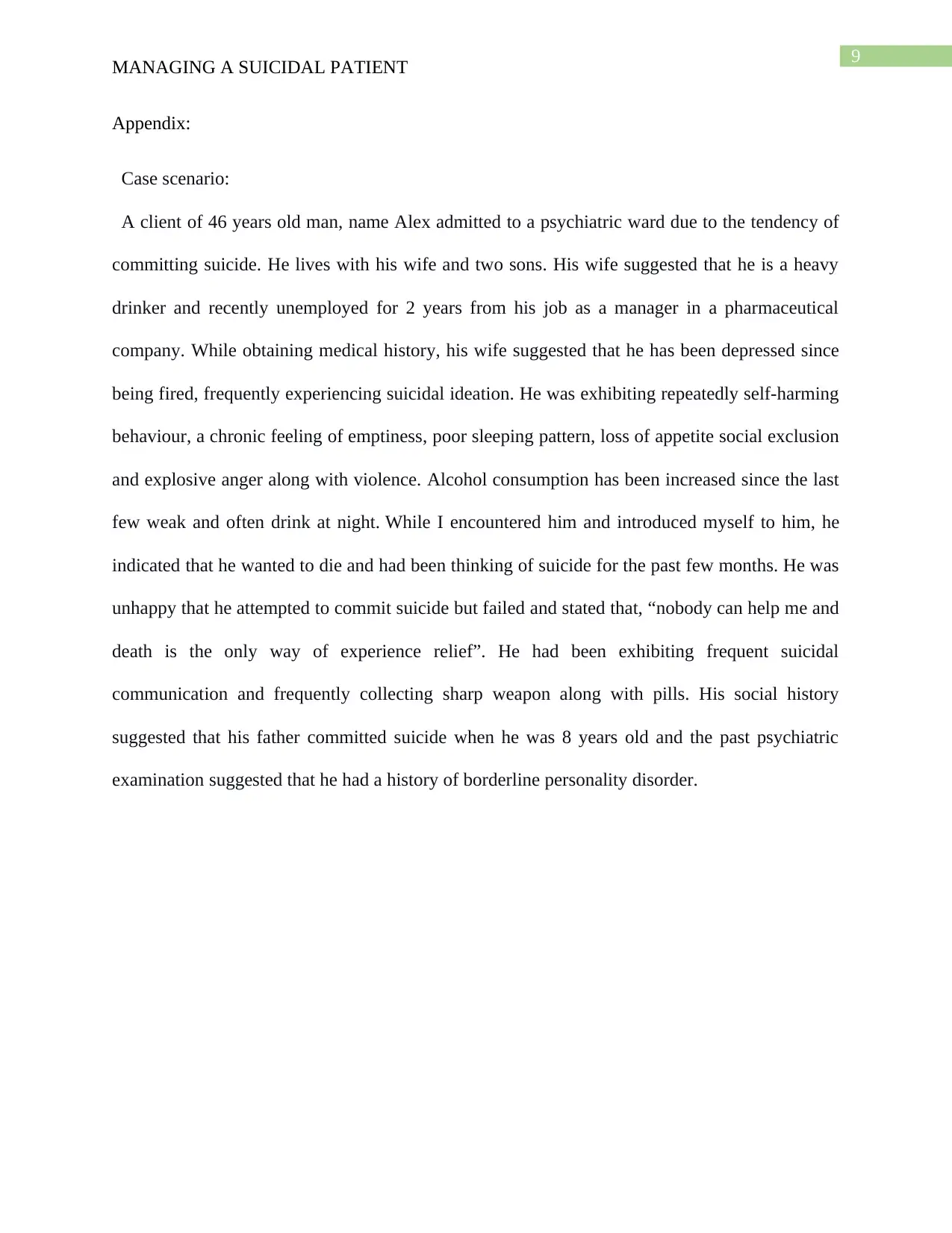
9
MANAGING A SUICIDAL PATIENT
Appendix:
Case scenario:
A client of 46 years old man, name Alex admitted to a psychiatric ward due to the tendency of
committing suicide. He lives with his wife and two sons. His wife suggested that he is a heavy
drinker and recently unemployed for 2 years from his job as a manager in a pharmaceutical
company. While obtaining medical history, his wife suggested that he has been depressed since
being fired, frequently experiencing suicidal ideation. He was exhibiting repeatedly self-harming
behaviour, a chronic feeling of emptiness, poor sleeping pattern, loss of appetite social exclusion
and explosive anger along with violence. Alcohol consumption has been increased since the last
few weak and often drink at night. While I encountered him and introduced myself to him, he
indicated that he wanted to die and had been thinking of suicide for the past few months. He was
unhappy that he attempted to commit suicide but failed and stated that, “nobody can help me and
death is the only way of experience relief”. He had been exhibiting frequent suicidal
communication and frequently collecting sharp weapon along with pills. His social history
suggested that his father committed suicide when he was 8 years old and the past psychiatric
examination suggested that he had a history of borderline personality disorder.
MANAGING A SUICIDAL PATIENT
Appendix:
Case scenario:
A client of 46 years old man, name Alex admitted to a psychiatric ward due to the tendency of
committing suicide. He lives with his wife and two sons. His wife suggested that he is a heavy
drinker and recently unemployed for 2 years from his job as a manager in a pharmaceutical
company. While obtaining medical history, his wife suggested that he has been depressed since
being fired, frequently experiencing suicidal ideation. He was exhibiting repeatedly self-harming
behaviour, a chronic feeling of emptiness, poor sleeping pattern, loss of appetite social exclusion
and explosive anger along with violence. Alcohol consumption has been increased since the last
few weak and often drink at night. While I encountered him and introduced myself to him, he
indicated that he wanted to die and had been thinking of suicide for the past few months. He was
unhappy that he attempted to commit suicide but failed and stated that, “nobody can help me and
death is the only way of experience relief”. He had been exhibiting frequent suicidal
communication and frequently collecting sharp weapon along with pills. His social history
suggested that his father committed suicide when he was 8 years old and the past psychiatric
examination suggested that he had a history of borderline personality disorder.
Paraphrase This Document
Need a fresh take? Get an instant paraphrase of this document with our AI Paraphraser

10
MANAGING A SUICIDAL PATIENT
References:
Burnette, A. G., Huang, F., Maeng, J. L., & Cornell, D. (2019). School threat assessment versus
suicide assessment: Statewide prevalence and case characteristics. Psychology in the
Schools, 56(3), 378-392.
Carter, G., Milner, A., McGill, K., Pirkis, J., Kapur, N., & Spittal, M. J. (2017). Predicting
suicidal behaviours using clinical instruments: systematic review and meta-analysis of
positive predictive values for risk scales. The British Journal of Psychiatry, 210(6), 387-
395.
Chu, C., Buchman-Schmitt, J. M., Stanley, I. H., Hom, M. A., Tucker, R. P., Hagan, C. R., ... &
Michaels, M. S. (2017). The interpersonal theory of suicide: A systematic review and
meta-analysis of a decade of cross-national research. Psychological bulletin, 143(12),
1313.
Dhingra, K., Klonsky, E. D., & Tapola, V. (2019). An empirical test of the Three‐Step Theory of
suicide in UK University students. Suicide and Life‐Threatening Behavior, 49(2), 478-
487.
Fernandes, S., & Naidu, S. (2017). Promoting participation in self care management among
patients with diabetes mellitus: An application of Peplau's Theory of Interpersonal
Relationships. International Journal of Nursing Education, 9(4), 129-134.
Fitzpatrick, S. J. (2020). Epistemic Justice and the Struggle for Critical Suicide Literacy. Social
Epistemology, 1-11.
MANAGING A SUICIDAL PATIENT
References:
Burnette, A. G., Huang, F., Maeng, J. L., & Cornell, D. (2019). School threat assessment versus
suicide assessment: Statewide prevalence and case characteristics. Psychology in the
Schools, 56(3), 378-392.
Carter, G., Milner, A., McGill, K., Pirkis, J., Kapur, N., & Spittal, M. J. (2017). Predicting
suicidal behaviours using clinical instruments: systematic review and meta-analysis of
positive predictive values for risk scales. The British Journal of Psychiatry, 210(6), 387-
395.
Chu, C., Buchman-Schmitt, J. M., Stanley, I. H., Hom, M. A., Tucker, R. P., Hagan, C. R., ... &
Michaels, M. S. (2017). The interpersonal theory of suicide: A systematic review and
meta-analysis of a decade of cross-national research. Psychological bulletin, 143(12),
1313.
Dhingra, K., Klonsky, E. D., & Tapola, V. (2019). An empirical test of the Three‐Step Theory of
suicide in UK University students. Suicide and Life‐Threatening Behavior, 49(2), 478-
487.
Fernandes, S., & Naidu, S. (2017). Promoting participation in self care management among
patients with diabetes mellitus: An application of Peplau's Theory of Interpersonal
Relationships. International Journal of Nursing Education, 9(4), 129-134.
Fitzpatrick, S. J. (2020). Epistemic Justice and the Struggle for Critical Suicide Literacy. Social
Epistemology, 1-11.
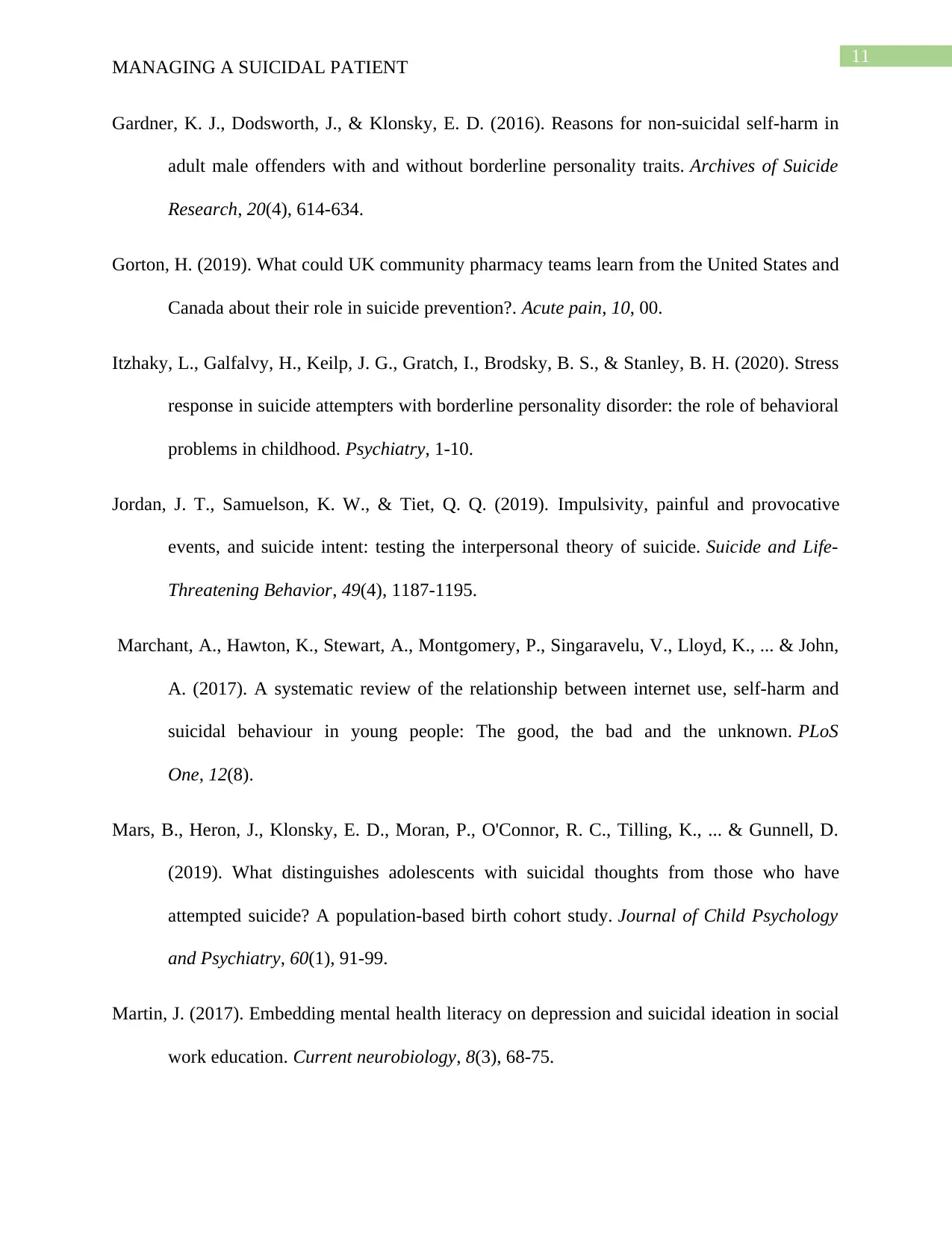
11
MANAGING A SUICIDAL PATIENT
Gardner, K. J., Dodsworth, J., & Klonsky, E. D. (2016). Reasons for non-suicidal self-harm in
adult male offenders with and without borderline personality traits. Archives of Suicide
Research, 20(4), 614-634.
Gorton, H. (2019). What could UK community pharmacy teams learn from the United States and
Canada about their role in suicide prevention?. Acute pain, 10, 00.
Itzhaky, L., Galfalvy, H., Keilp, J. G., Gratch, I., Brodsky, B. S., & Stanley, B. H. (2020). Stress
response in suicide attempters with borderline personality disorder: the role of behavioral
problems in childhood. Psychiatry, 1-10.
Jordan, J. T., Samuelson, K. W., & Tiet, Q. Q. (2019). Impulsivity, painful and provocative
events, and suicide intent: testing the interpersonal theory of suicide. Suicide and Life‐
Threatening Behavior, 49(4), 1187-1195.
Marchant, A., Hawton, K., Stewart, A., Montgomery, P., Singaravelu, V., Lloyd, K., ... & John,
A. (2017). A systematic review of the relationship between internet use, self-harm and
suicidal behaviour in young people: The good, the bad and the unknown. PLoS
One, 12(8).
Mars, B., Heron, J., Klonsky, E. D., Moran, P., O'Connor, R. C., Tilling, K., ... & Gunnell, D.
(2019). What distinguishes adolescents with suicidal thoughts from those who have
attempted suicide? A population‐based birth cohort study. Journal of Child Psychology
and Psychiatry, 60(1), 91-99.
Martin, J. (2017). Embedding mental health literacy on depression and suicidal ideation in social
work education. Current neurobiology, 8(3), 68-75.
MANAGING A SUICIDAL PATIENT
Gardner, K. J., Dodsworth, J., & Klonsky, E. D. (2016). Reasons for non-suicidal self-harm in
adult male offenders with and without borderline personality traits. Archives of Suicide
Research, 20(4), 614-634.
Gorton, H. (2019). What could UK community pharmacy teams learn from the United States and
Canada about their role in suicide prevention?. Acute pain, 10, 00.
Itzhaky, L., Galfalvy, H., Keilp, J. G., Gratch, I., Brodsky, B. S., & Stanley, B. H. (2020). Stress
response in suicide attempters with borderline personality disorder: the role of behavioral
problems in childhood. Psychiatry, 1-10.
Jordan, J. T., Samuelson, K. W., & Tiet, Q. Q. (2019). Impulsivity, painful and provocative
events, and suicide intent: testing the interpersonal theory of suicide. Suicide and Life‐
Threatening Behavior, 49(4), 1187-1195.
Marchant, A., Hawton, K., Stewart, A., Montgomery, P., Singaravelu, V., Lloyd, K., ... & John,
A. (2017). A systematic review of the relationship between internet use, self-harm and
suicidal behaviour in young people: The good, the bad and the unknown. PLoS
One, 12(8).
Mars, B., Heron, J., Klonsky, E. D., Moran, P., O'Connor, R. C., Tilling, K., ... & Gunnell, D.
(2019). What distinguishes adolescents with suicidal thoughts from those who have
attempted suicide? A population‐based birth cohort study. Journal of Child Psychology
and Psychiatry, 60(1), 91-99.
Martin, J. (2017). Embedding mental health literacy on depression and suicidal ideation in social
work education. Current neurobiology, 8(3), 68-75.
⊘ This is a preview!⊘
Do you want full access?
Subscribe today to unlock all pages.

Trusted by 1+ million students worldwide
1 out of 14
Related Documents
Your All-in-One AI-Powered Toolkit for Academic Success.
+13062052269
info@desklib.com
Available 24*7 on WhatsApp / Email
![[object Object]](/_next/static/media/star-bottom.7253800d.svg)
Unlock your academic potential
Copyright © 2020–2025 A2Z Services. All Rights Reserved. Developed and managed by ZUCOL.





